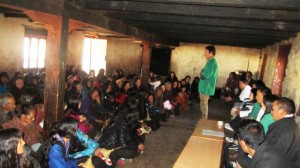Laya farmers receive orientation to have healthy animals

The farmers in the remotest district of Bhutan received orientation on how they would effectively reduce the impact of Gid diseases among their yaks.
The campaign run by Regional Livestock Development Centre (RLDC), Wangdue in collaboration with Gasa district administration saw huge crowd of villagers willing to learn techniques to have their animals healthy.
Gid is a condition caused by a tapeworm, the lifecycle of which is partially completed in dogs (definitive host) and then in yaks (intermediate host). Every year, it causes heavy loss to the farmers of the regions through calf mortality.
The campaign with the theme “Effective and sustainable animal health services to the highlanders” followed multiple approaches to control the disease in a different inter-face: definitive host, intermediate host and the environment. A research component with an aim to formulate appropriate control measures in the future was also carried out. These approaches are expected to effectively and efficiently prevent, control and ultimately eliminate the disease from the community.
During the campaign, the team consisting of veterinarians and laboratory technicians from RLDC (Wangdue), Gasa, Tsirang, Dagana and Punakha sterilised, vaccinated and dewormed around 105 dogs and 200 yaks covering the eight villages. They also collected around 75 blood and fecal samples from these animals for research.
They also trained community animal health workers on how to go about gid issues in future. These trained members are expected to continue their support during gid emergence as well as render basic animal health services to the remotest areas.
